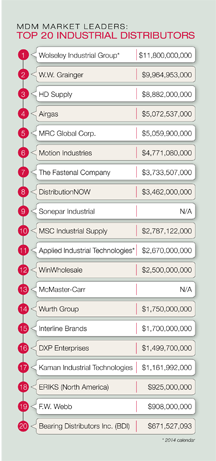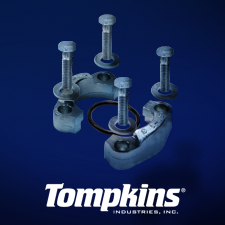Top 20 Industrial Distributors

by Jenel Stelton-Holtmeier
 Double-digit growth was not uncommon for the distributors on MDM’s list of the top 40 industrial distributors for 2015. The list, which presents the largest distributors in North America, was recently released and is now available at mdm.com.
Double-digit growth was not uncommon for the distributors on MDM’s list of the top 40 industrial distributors for 2015. The list, which presents the largest distributors in North America, was recently released and is now available at mdm.com.
Wolseley Industrial Group – made up of Wolseley’s North American businesses Ferguson Enterprises and Wolseley Canada – again leads the Top 40 Industrial Distributors list from Modern Distribution Management in 2015. Chicago-based Grainger’s sales neared $10 billion in 2014, landing it in the No. 2 position. And No. 3 HD Supply continued its solid sales growth, hitting $8.9 billion for the year.
Acquisitions drove some of the fastest-growing companies on the list this year; Sonepar moved into the Top 10 due to its acquisition of last year’s No. 22 company, Industrial Distribution Group. Kaman Industrial Technologies also continued its growth trajectory
through acquisition, which included building its fluid power platform through the acquisition of B.W. Rogers in February 2014.
Despite strong growth for many of the top companies last year, optimism remains cautious. Volatility in the price of crude oil continues to be a concern for many industrial distributors, particularly those that directly serve the oil and gas industry. But the impacts are far broader than that end market.
As part of the 2015 Market Leaders, MDM also publishes the annual Distribution Trends Special Issue. Here are some of the trends MDM is tracking this year:
- Investment in technology is accelerating, with a focus on integrated systems. As the focus on making data-based decisions with analytics grows, so does recognition that the software already in place may not be enough. Distributors want to ensure that the data in each of their systems can be used with the data from other systems. Salespeople need access to real-time pricing, availability and alternatives at their fingertips, meaning ERP, warehouse and product information has to be accessible from a mobile device, for example.
- E-commerce is critical, but it’s not enough. Customers want a multichannel experience, not just for buying, but also for research, support and account information. Distributors are looking for ways to provide an integrated experience on- and off-line at all points in the relationship.
- While technology investment is growing, there’s renewed focus on business basics. As one distributor noted: What good is investing in an e-commerce platform if you can’t deliver the product? Technology won’t resolve the issues within a business by itself, but it can make resolving the issues easier or more effective.
- Human resource issues – from hiring to retiring – remain a top concern for distributors, as the prevailing workforce continues to age. Of particular concern is how to transfer the knowledge of industry veterans to a less experienced workforce. But the flip side is also true: How can the knowledge that the new workforce has regarding their generation be transferred to the veteran workers? Generational shift isn’t occurring only in the employee base; it is also happening to the buyers. This recognition contributes to a lessening of the “us versus them” mentality between the generations that marked the past few years.
- Vending is no longer a standalone conversation. Inventory management is as important as ever, and vending is, as well. But there’s more focus on having comprehensive conversations about how to improve overall inventory usage and monitoring. Requests for those types of comprehensive programs continue to increase, as has willingness to pay for outcomes from programs. But the value must be measurable and documented.
Methodology
Data for MDM’s lists of top distributors were based on 2014 revenue size alone. In most cases, we used fiscal 2014 revenue, but in some cases, MDM used calendar-year revenues for an apples-to-apples comparison. Calendar-year measures were based on either Jan. 1, 2014-Dec. 31, 2014, or Feb. 1, 2014-Jan. 31, 2015, depending on when quarterly breaks occurred. To collect data, we used SEC annual filings for public companies. For non-public companies, companies were asked to provide data about revenues. In the end, not every company was willing to provide revenue data, yet we deemed it important to include them anyway. We utilized several resources to estimate where to place these companies. Revenues for all companies in this report are in U.S. dollars. For companies who report their data in other currencies, we converted their revenues to U.S. dollars using the exchange rate in place on the last day of that company’s fiscal or calendar year to determine ranking.
 Jenel Stelton-Holtmeier is editor of Modern Distribution Management and mdm.com, a specialized newsletter and website for wholesale distribution executives. Reach
Jenel Stelton-Holtmeier is editor of Modern Distribution Management and mdm.com, a specialized newsletter and website for wholesale distribution executives. Reach
her at jenel@mdm.com.













